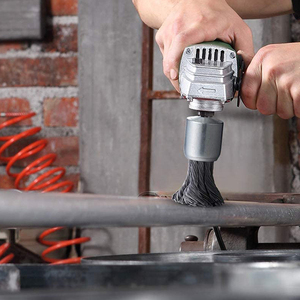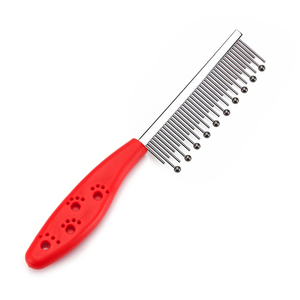(3628 products available)






















































































































































































An inox wire brush is a durable tool used in various settings, such as in households, industries, and construction work. It is widely used to clean, deburr, or prepare metal surfaces, especially for stainless steel. It usually has stainless steel wire bristles with excellent wear resistance and is ideal for heavy-duty cleaning tasks. Wire brushes come in various shapes, including flat-bristle wheel brushes, cylindrical, cup, or pointed-tipped brushes, which can be attached to a hand tool or power tool.
The inox cup brush is a small brush with tightly packed bristles in a cup or cylindrical shape. It is used with an angle grinder or power tools to remove rust, paint, and oxidisation and is ideal for flat areas or hard-to-reach spaces like corners. It is made with stainless steel bristles, and compared to other brushes, it is more durable and resistant to corrosion. A cup brush can also be used for concrete or masonry surfaces. Bristles are available in different diameters, ranging from a few centimetres to about 10 cm. Fine- and medium-bristle brushes are used for light-duty cleaning, while those with coarse bristles are suitable for heavy-duty tasks.
These stainless steel bristle brushes are made for cleaning, polishing, or sanding metal and non-metal surfaces. Majority have stainless steel bristles, though they vary in shape, size, and bristle configuration according to the task at hand. They are used for deburring, surface preparation, finishing, rust and paint removal, and other tasks in industries like manufacturing, construction, and automotive to clean hard-to-reach areas without damaging the metal or surface. In polishing and sanding, they provide a smooth, reflective finish on metal surfaces, mostly in high-visibility areas, especially for aesthetic purposes.
The inox handheld wire brush is a small cleaning brush with a stainless steel wire bristle on one end and a scraper on the opposite side of the flat bristle brush. It is ideal for light brushing and cleaning small metal work or tight spaces. The wire bristles easily get into crevices, and the scraper removes debris.
Inox brushes can be ideal for rust removal because they have bristles made of stainless steel, which is denser and wears less than a typical metal brush. It also resists corrosion and is suitable for cleaning iron and steel exposed to moisture and air. A wire or cup Inox brush is used to remove rust on metal surfaces, restoring functionality and extending lifespan.
Inox brushes, either wire or cup, are used to remove paint from surfaces. The wire bristles, stainless steel bristles easily embedded in fibres of old paint, peeling and lifting it, making it ideal for preparing surfaces for new paint applications. Inox brushes are also effective for working on rough, flat, and contoured surfaces, particularly in spots where the paint is difficult to strip by hand or with chemical assistance.
It is important to prepare the surface before a welding process to ensure a strong joint and minimise impurities. Inox brushes accomplish this task by wiping the welding surface clean of rust, paint, and oxide layers. It creates a cleaner surface better for penetration in welding. They are also useful for stainless steel and other metals where maintaining surface integrity is crucial.
After surface preparation, new and old surfaces appear shiny, nearly identical. Stainless steel bristle brushes are good for surface finishing, producing smooth, reflective surfaces and improving aesthetic and functional qualities. Different industrials' areas seek standard finishes and uniformity on available metal surfaces, especially on stainless steel surfaces found in medical, aerospace, and food processing industries.
Frequent exposure of metal surface to air and moisture causes oxidation and corrosion. It gradually deteriorates the metal underneath. Inox brushes are effective in removing corrosion and restoring surface shine and texture. Stainless steel bristles are tough, thus suitable for cleaning iron and steel surfaces experiencing severe corrosion. Cup Inox or wire brushes embedded in hard machinery parts or wide metal surfaces easily removed adherent corrosion deposits. They prepare these surfaces either for protective coating application or to improve functionality and extend their lifespan. Apart from all these, Regular maintenance with Inox brushes on industrial equipment, tools and hardware prevents accumulation of corrosion over time.
Inox brushes perform various jobs, making them valuable for industries like automotive, aerospace, and construction. They are effective on welding, machining, and surface finishing to meet cleanliness and quality enhancement demands. Their versatility makes them suited for multiple applications, eliminating the need for specialised brushes and therefore increasing efficiency. Strong demand for rust- and paint-removal tools and welding surface prep tools ensures a constant need for these Inox brushes, guaranteeing manifold sales in hardware stores.
Inox brushes are typically produced in large numbers. As a result, paint removal brushes and other varieties are less expensive, thereby benefitting wholesalers and distributors. Made available at competitive prices in bulk, they could be marketed across various channels, such as industrial distributors and retail hardware stores. Inox brushes can be marketed and sold in various sizes, shapes, and configurations to meet the needs of different customers, such as industrial clients needing heavy-duty brushes or DIY consumers requiring lighter-duty versions. Customisable options also increase their appeal.
Inox brushes incorporate stainless steel wire bristles strongly resistant to corrosion, making them ideal for harsh conditions or marine environments. All kinds of Inox brushes feature stainless steel bristles, which are non-corrosive. They suit them for tasks involving stainless steel or other metals, where regular steel bristles will impart microscopic steel particles resulting in rust streaks over time. Stainless steel will also wear less than regular steel, and this makes Inox brushes better suited for heavy-duty applications like paint stripping or metal finishing.
While selecting Inox brushes, size plays an important role since smaller brushes get into tight spaces, while larger ones are for flat or wide surfaces. Consider the job requirements so that the right size can be purchased, and a variety are stocked to tackle any upcoming jobs.
Inox brushes come in different shapes like hand-held, wire wheels, cup brushes, or tapered point brushesfor different tasks. A hand-held brush is fitting for light cleaning, debris removal, or rust in small spaces. Heavy-duty jobs, including rust removal and paint stripping on wide surfaces, suit wire wheelsand cup brushes, while pointed brushes are for detailed work on confined areas and intricate sections.
Bristle thickness plays a role in performance. Coarse bristles offer heavy-duty work like rust or paint stripping in an intense build-up. Detailed work on metal and smooth finishing requires fine bristles. It is ideal to stock bristles with varying thicknesses since various jobs require particular bristle thickness.
If the Inox brush is not meant to be hand held, check whether the brush is compatible with the power tool. Certain brushes are for specific tools like angle grinders or drills. Also, check the RPM rating on the brush. It guarantees safe and effective operation, so ensure to match the tool's speed with the brush's RPM.
A. To maintain and extend the lifespan of Inox brushes, one should regularly clean the brushes after use by running them through metal to remove material stuck between the bristles. For wire brushes, one should do it by hand, but for cup brushes, use an air blower. Avoid putting too much pressure on the brush when storing it, and if possible, store it separately from other tools to avoid bending the bristles. A brush guard, where available, should be used. A cup brush should occasionally run an RPM cleaner through it to detach debris. Lastly, routinely check for bristle wear or damage and replace the brush when highly worn out.
A. Some dangers associated with using Inox brushes for rust removal include flying debriscreated when metal particles or rust learn to braid from the brushed surface. Always wear eye protection to avert this. Another problem is brush breakage; Inox brushes are known to shatter or break, which poses a risk, so using a brush guard and maintaining proper posture is advised. Additionally, vibrationfrom power tools could cause discomfort or long-term injury in the hands and arms holding the tool, so one should take breaks and use anti-vibration gear. Finally, Inox brushes generate high heat, which could potentially cause burns. It is important to always handle them with caution.
A. There are alternatives for inox brushes that are not made of stainless steel, though they don't perform as well. Steel wire brushes are cheaper and suitable for light-duty tasks on ferrous metals that aren't exposed to moisture. Brass wire brushes are gentler, ideal for rust on non-ferrous metals like copper and aluminium. Diamond grinding wheels are useful for heavy corrosion, providing a smooth finish, but they're less flexible than Inox brushes. For specific applications, such as welded areas, flap discs are good for edge work and corrosion removal without scoring, offering a more controlled finish.
There are several occasions when inox brushes should be replaced. Whenever a noticeable drop in brushing effectiveness occurs, when bristle breakages or bending become excessive, when the brush body becomes warped or damaged, if there is severe rusting on the cup or wheel brushes, or when there is visible wear and tear, like on tapered bristle brushes, and whenever one feels a need to maintain the quality of work.